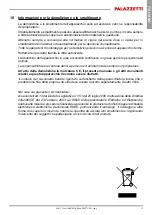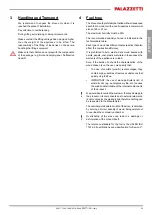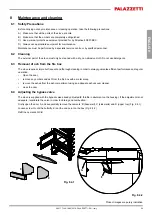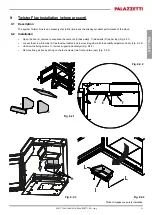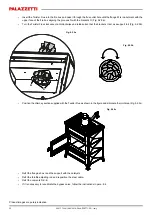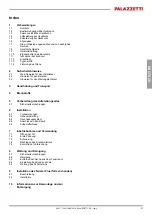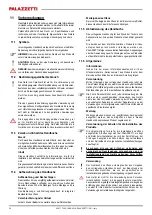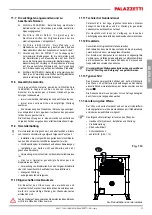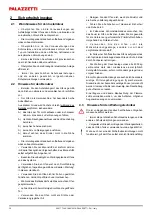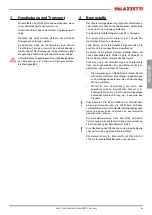
26
00 477 7300- 18/02/2019 - PALAZZETTI - PN - Italy
A
7.2.1 Fuel type
The reference standard for the fuel is the UNI EN ISO
17222-5 “specifications and classification for firewood”.
The stove should preferably be fuelled with well seasoned
beech/birch wood or with wood briquettes in commercial
sizes of 25 or 33 cm.
The humidity must be at most 25%.
Each type of wood has different characteristics that also
affect the combustion efficiency.
The use of conifers (pine-fir) is discouraged: they contain high
quantities of resinous substances that quickly clog the flue.
It is prohibited to burn: waste, bark, wood treated with
paints, panels, coal, plastic materials; in these cases the
warranty of the appliance is voided.
The nominal yield declared in kW of the stove, is obtained
by burning a correct quantity of wood, being careful not
to overload the combustion chamber.
The recommended quantity of wood is indicated in the
technical data table.
È it is absolutely forbidden to make use of any type of
coal, wood treated with wood protection substances,
cardboard and paper (use only for ignition).
IT IS forbidden to use the stove as incinerator. The
combustion of waste is prohibited in accordance with the
law on gas discharges. The burned gases resulting from
the combustion may cause damage to the stove, to the
flue and damage your health.
7 Commissioning and use
7.1 Door opening
Open the door using the handle (A) supplied. Carefully
insert the tool in the appropriate side seat paying attention
not to damage the glass and twist it upwards to open the
door and downwards to close it.
The door should be opened gradually so the smoke can
be drawn up the flue and not in the room. When lighting
the stove, and until it reaches the right temperature, it
should burn for a few minutes with the door ajar so that
the condensation that forms on the glass can evaporate.
Once the fire is burning well, close the door to optimise
yield and consequently, wood consumption.
7.2
Lighting for the first time
Check that all moving parts are well positioned and that
the air regulator and the smoke valve function correctly.
The first lighting (after the installation or at the beginning
of the season) must be carried out with reduced loads (~
1 kg/h) keeping the device on for at least 4 hours at low
rate. Proceed with these feed rates for at least three days
before using the appliance at its full capacity. This will
allow for the evaporation of any moisture accumulated
in the refractory elements when not used.
Light the fire using old and finely chopped wood so that
the flame develops as much as possible. Once the fire
is going well you can use larger pieces of wood provided
they are dry.
The first time you light the fireplace smoke and unpleasant
odours might form and escape due to the complete drying
of some of the materials used. This phenomenon will
gradually disappear.
Never use alcohol, petrol, kerosene or other liquid fuels
to light the fire. Keep these substances away from the
fire. Do not use petrol or chemical origin fire-lighters
as they can seriously damage the walls of the firebox .
Only use ecological fire lighting aids.
Do not touch the painted parts during the first lightings
to avoid damaging the paint finish.
During the first lightings, we recommend that you keep
the premises well ventilated.






